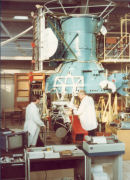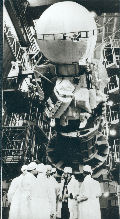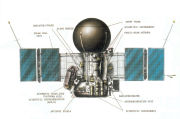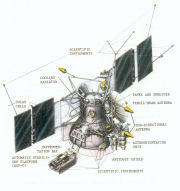








|
The
Vega mission
This
spacecraft mission combined a Venus swing-by with a Comet Halley
fly-by. Two identical spacecrafts, Vega 1 and Vega 2, were launched on
December 15 and 21, 1984, respectively. Having carried Venus entry
probes to the vicinity of Venus (arrival and deployment of probes were
scheduled for June 11 & 15, 1985), the two spacecrafts were
retargeted using Venus gravity field assistance to intercept Comet
Halley in March 1986. The first spacecraft encountered Comet Halley on
March 6, 1986, while the second one three days later. The fly-by
velocity was 77.7 km/s. Although the spacecraft could be targeted with
a precision of 100 km, the position of the spacecraft relative to the
comet nucleus was estimated to be known only to within a few thousand
kilometers. This, together with the problem of dust protection, led to
the estimated fly-by distances of 10.000 km for the first spacecraft
and 3.000 km for the second.
Halley’s comet
approaches the Earth once every 76 years. In 1986 the unique
opportunity was given to study the comet with instruments. The
scientific program of the Vega mission was realised by widespread
international co-operation (Soviet Union, Austria, Bulgaria,
Czechoslovakia, FRG, France, GDR, Poland and Hungary).
The spacecrafts carried
14 experiments, among them the Imaging and Tracking System, the
so-called TV System (TVS) for tracking and imaging the inner coma and
comet nucleus. The TVS, placed on a pointing platform, consisted of a
narrow-angle camera (NAC), a wide-angle camera (WAC), and a processor
unit. Optical parts of the TVS were built partly by French and Russian
scientists. The WAC was to be used for large-scale coma imaging and as
a guide for the NAC. The basic task of the NAC was imaging the nucleus
and the surrounding area of Comet Halley; that of the WAC was directing
the pointing platform and its instruments to the object of examination.
Both cameras used CCDs with 512 x 576 pixels each as detecting devices
in the focal plane. Combined data rate for the two cameras was 48 kbps,
which was not sufficient to transmit the full contents of the CCDs.
Only a “window”, one-tenth of the area of the CCDs around the center of
brightness was transmitted. The exposure time had to be kept short to
keep image blur to a minimum, but it could not be less than 0.01 s if
good sensitivity had to be achieved. The narrow-angle camera could
resolve nucleus surface structures down to 200 m from a distance of
10.000 km. A set of filters (500 to 1050 nm) with a relatively wide (80
nm) passband was used in the NAC. The WAC filter covered the range 630
to 760 nm. The NAC had a focal length of 1200 mm, an f-number of f/6,
and a 0.5-deg field of view; these parameters for the WAC were 100 mm,
f/2, and 4 degrees, respectively. In addition to the purely scientific
objectives of imaging the nucleus, the cameras also had the task of
providing the information needed to determine the spacecraft’s
trajectory relative to the nucleus.
Our
team members, as employees of KFKI RMKI had designed and realised the
electronic part of the TVS with two microcomputers. One of them
controlled the imaging, maintained communication with the Earth
(downloading information and processing uplink commands). The task of
the second computer was to recognise the comet and to track it by
controlling the platform motion. This was the first time in the history
of space research that real-time autonomous control was realised
through onboard picture processing. The most sensitive and critical
components of both computers (memory, clock generator) had hot
redundancy. In addition, the DPU contained back-up systems for tracking
and communication. They were designed on different technological bases
for the same function, so that any eventually unrevealed systematic
error in the design or manufacture could affect only the subsystem in
question, but not the functionality of the whole system.
The TVS
transmitted about 1500 images to the Earth and the nucleus of Halley’s
comet was observed for the first time in history. Its shape, surface
features and activity mechanism were derived. Cometary nuclei are
considered to belong to the oldest, most primitive population of solar
system bodies, thus their investigation contributes to understanding
the formation of the solar system.
24.March
2015
|

Vega
s/c
integration
in
IKI

Vega
s/c
integration
in
Bajkonur

Instrument on the VEGA

Instrument on the VEGA
s/c after Venus

First
images of the Haley's
nucleus
|


